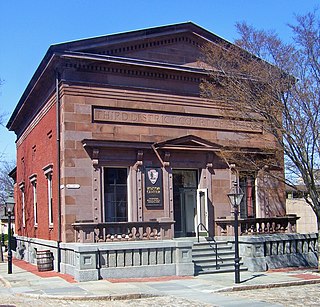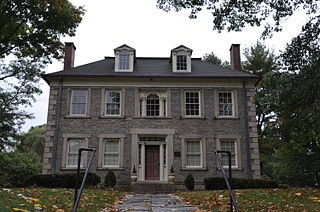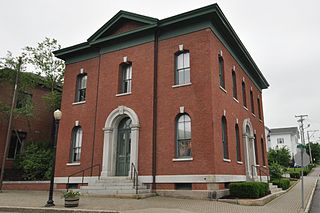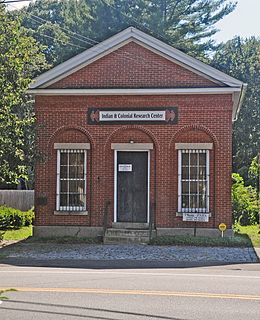
The Custom House Tower is a skyscraper in McKinley Square, in the Financial District neighborhood of Boston, Massachusetts. The original building was constructed in 1837–47 and was designed by Ammi Burnham Young in the Greek Revival style. The tower was designed by Peabody and Stearns and was added in 1913–15. The building is part of the Custom House District, which was added to the National Register of Historic Places in 1973.

The Salem Maritime National Historic Site is a National Historic Site consisting of 12 historic structures, one replica tall-ship, and about 9 acres of land along the waterfront of Salem Harbor in Salem, Massachusetts. Salem Maritime is the first National Historic Site established in the United States. It interprets the Triangle Trade during the colonial period, in cotton, rum, sugar and slaves; the actions of privateers during the American Revolution; and global maritime trade with the Far East, after independence. The National Park Service manages both the National Historic Site and a Regional Visitor Center in downtown Salem. The National Park Service (NPS) is an agency of the United States Department of the Interior.

The Downtown New London Historic District, also known as the Waterfront Historic District, refers to 78 acres (32 ha) with 223 contributing buildings along the waterfront of New London, Connecticut. It was added to the National Register of Historic Places (NRHP) in 1979, with 190 buildings and 60 acres (24 ha). The district was expanded in 1988, adding 18 acres (7.3 ha) and 33 buildings.

The New Bedford Historic District is a National Historic Landmark District in New Bedford, Massachusetts, United States, west of the community's waterfront. During the 19th century, when the city was the center of the American whaling industry, this was its downtown. After its decline in the early and mid-20th century, through the efforts of local activist groups the district has since been preserved and restored to appear much as it was during that period.

The Noank Historic District is a historic district encompassing the historic main part of the village of Noank in the town of Groton, Connecticut. The district contains a distinctive assortment of mid-to-late 19th-century residential architecture that is notable for its often picturesque woodwork. At the time of their construction, the village was primarily a worker village for nearby shipyards. The district was listed on the National Register of Historic Places in 1979.

The Old Third District Courthouse in New Bedford, Massachusetts, United States, is located at the corner of Second and William streets. It was built in 1853 by Russell Warren in the Greek Revival architectural style, as the home of the New Bedford Institute for Savings, a local bank. After the bank moved, the Bristol County courts came in. They, too, eventually outgrew it and moved elsewhere in the city. Since the creation of New Bedford Whaling National Historic Park in 1996, it has been used by the National Park Service (NPS) as the park's visitor center.

The U.S. Custom House or U.S. Customhouse is the custom house in Charleston, South Carolina. Construction began in 1852, but was interrupted in 1859 due to costs and the possibility of South Carolina's secession from the Union. After the Civil War, construction was restarted in 1870 and completed in 1879. The building was placed on the National Register of Historic Places on October 9, 1974. It is also a contributing property of the Charleston Historic District.

The U.S. Custom House, also known as the Old Post Office and Custom House, is a historic government building at 423 Canal Street in New Orleans, Louisiana. It was designated a National Historic Landmark, receiving this designation in 1974 and noted for its Egyptian Revival columns. Construction on the building, designed to house multiple federal offices and store goods, began in 1848 and didn't finish until 1881 due to redesigns and the American Civil War. The U.S. Customs offices have been located there since the late 19th century.

The United States Custom House is a historic custom house at 312 Fore Street in downtown Portland, Maine. It was built from 1867–1872 to house offices of the United States Customs Service, and was listed on the National Register of Historic Places in 1973.

The United States Customhouse is a historic and active custom house at 2nd and William Streets in New Bedford, Massachusetts. Architect Robert Mills designed the custom house in 1834 in a Greek Revival style. It has been used by the U.S. Customs Service ever since, and today serves as a port of entry.

The Gerald W. Heaney Federal Building, United States Courthouse and Custom House in Duluth, Minnesota is a courthouse of the United States District Court for the District of Minnesota. Completed in 1930, it is part of the Duluth Civic Center Historic District, listed on the National Register of Historic Places in 1986. In 2007 the United States Congress passed an act to rename the building for former Circuit Court judge Gerald Heaney. It was enacted into law that same year.

The U.S. Customhouse is a historic custom house in Portland in Multnomah County, Oregon. It was constructed to house offices of the United States Customs Service. It was built in 1898–1901 and is listed on the U.S. National Register of Historic Places. It is slated to be used as the second Portland, Oregon location for Industrious, a coworking space provider in Spring 2022.

The Shaw Mansion is a historic mansion and historic house museum at 11 Blinman Street in New London, Connecticut. Built in 1756, it is a well-preserved example of a wealthy merchant's house, made further notable as the location of the state's naval offices during the American Revolutionary War. It was added to the National Register of Historic Places in 1970. The headquarters and museum of the New London County Historical Society have been located in the Shaw Mansion since 1907.

The Post Hill Historic District encompasses the oldest settled area of New London, Connecticut.

The Custom House in Boston, Massachusetts, was established in the 17th century and stood near the waterfront in several successive locations through the years. In 1849 the U.S. federal government constructed a neoclassical building on State Street; it remains the "Custom House" known to Bostonians today. A tower was added in 1915; the building joined the National Register of Historic Places in 1973 and was designated a Boston Landmark by the Boston Landmarks Commission in 1986.

The Deshon-Allyn House is a historic house at 613 Williams Street in New London, Connecticut built in 1829 for the captain of a whaling ship and is a fine example of transitional Federal-Greek Revival architecture. The house is now on the campus of the Lyman Allyn Art Museum, which has used it for a variety of purposes. It was listed on the National Register of Historic Places on October 28, 1970.

The United States Customhouse and Post Office, also known as the Old Customhouse, is a historic federal government building at Fore and Water Streets in Wiscasset, Maine. It was designed by Alfred B. Mullett and built in 1869–1870 by William Hogan of Bath, Maine. It was added to the National Register of Historic Places on August 25, 1970. It has been a private residence since purchased by Entrepreneur Jack Nelson and his wife Stacy in October 2013.

The former Machias Post Office and Customhouse is a historic government building at Maine and Center Streets in Machias, Maine. Built in 1872, it is a prominent local example of Italianate architecture executed in brick. The building was listed on the National Register of Historic Places in 1977. It now houses offices of the Machias Savings Bank.

The Exeter Waterfront Commercial Historic District encompasses the historic commercial and residential waterfront areas of Exeter, New Hampshire. The district extends along the north side of Water Street, roughly from Main Street to Front Street, and then along both sides of Water and High streets to the latter's junction with Portsmouth Street. It also includes properties on Chestnut Street on the north side of the Squamscott River. This area was where the early settlement of Exeter took place in 1638, and soon developed as a shipbuilding center. The district was listed on the National Register of Historic Places in 1980. It was enlarged in 1986 to include the mill complex of the Exeter Manufacturing Company on Chestnut Street.

The Mystic Bank is a historic commercial building at 39 Main Street in the Old Mystic village of Stonington, Connecticut. Built in 1856 for a bank founded in 1833, it was used by the town as a meeting hall after the bank closed in 1884, and now houses offices. It is a good example of a small 19th-century Greek Revival brick bank building. It was listed on the National Register of Historic Places in 2014.






















